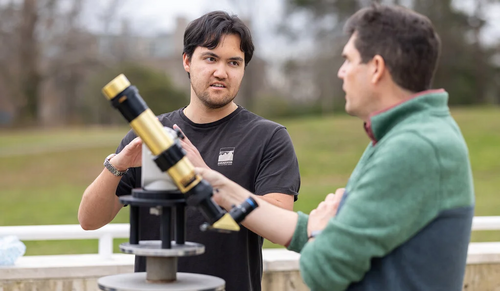
Visitors to Yale’s Leitner Family Observatory and Planetarium on Monday, April 8 will see the moon cover 91% of the sun (weather permitting).
Next week, when a total solar eclipse traces a narrow path across the United States, Christopher Lindsay, a fourth year Ph.D. candidate in astronomy and Gruber Science Fellow in Yale’s Graduate School of Arts and Sciences, won’t be chasing its “path of totality.”
He’ll follow another lofty calling instead — helping to conduct a scientific symphony of telescopes, sunspotters, pinhole projectors, and kitchen colanders at a public viewing event at Yale’s Leitner Family Observatory and Planetarium.
A limited number of eclipse-viewing glasses will be available, and student volunteers and staff will be on hand to assist visitors who want to safely view the celestial event.
“I’ve been lucky enough to see two previous solar eclipses, in Oregon in 2017 and in Chile in 2019,” Lindsay said. “For this one, I wanted to help with some science outreach. That’s part of being a scientist, too.”
While Connecticut will not have a full view of the total eclipse, the Leitner Family Observatory and Planetarium, at 355 Prospect St. on Science Hill, will host an eclipse viewing event on the lawn beginning at 2 p.m. on April 8. A limited number of eclipse-viewing glasses will be available, and student volunteers and staff will be on hand to assist visitors who want to safely view the celestial event.
The observatory building itself will be closed during the viewing event.
Lines to view the eclipse through a telescope or sunspotter may be long, warned Kristin Kampp, program coordinator for the observatory. A partial eclipse viewing in 2017 drew hundreds of people to the observatory. And since it is not safe to look at the sun during a partial eclipse without proper protection, Kampp recommended that visitors bring their own pinhole projector in addition to eclipse glasses, if possible.
Sunspotters are wooden instruments that use mirrors and lenses to safely show a projection of the Sun’s image; pinhole projectors and colanders are able to do this, also.
In the United States, the path of the April 8 eclipse — in which the moon will cover the sun — begins in Texas and travels northeast into portions of Oklahoma, Arkansas, Missouri, Illinois, Kentucky, Indiana, Ohio, Pennsylvania, New York, Vermont, New Hampshire, and Maine. The eclipse path is 115 miles wide.

“New Haven will see a partial eclipse,” said Michael Faison, director of the observatory, academic director for the Yale Summer Program in Astrophysics, and senior lecturer in the Department of Astronomy in Yale’s Faculty of Arts and Sciences. “It will peak at 91% here at 3:25 p.m. that day.”
Some Yale astronomy students and faculty members will be traveling to various locations in the path of totality, the area where a full eclipse can be observed. For example, Sarbani Basu, the William K. Lanman, Jr. Professor of Astronomy and a leading researcher on the structure of the sun, will be in Oswego, N.Y., and Faison will be in Oberlin, Ohio.
Meg Urry, the Israel Munson Professor of Physics and Astronomy, will be in Texas to lead a Yale alumni eclipse-viewing trip. “Many of my colleagues do experiments during the eclipse, but solar astronomy is far from my expertise,” she said. “I’m afraid I watch eclipses as an amateur.”
Some Yale astronomy students and faculty members will be traveling to various locations in the path of totality, the area where a full eclipse can be observed.
She continued: “I think about what it must have been like long ago for farmers working in the fields, seeing the skies slowly darken over the course of an hour — probably they don’t even pause to look up, perhaps they think it’s going to rain. And then suddenly there is nighttime darkness. The source of light and warmth is snuffed out completely.
“I can’t help but wonder about the terror it must have caused,” she said. “And then, a few minutes later, the sun returns, and all is well.”
For Urry, one of the highlights of eclipse watching is the sense of community that brightens spirits even as the skies darken. It’s often a mix of experienced stargazers with fancy equipment and newbies eager to see something unusual, she explained.
Lindsay will be ready for both types of eclipse watchers — and the questions they will have — during this year’s event.
If someone wants to talk about the sun’s magnetic field, and how it is imprinted on the solar corona — well, that’s right in Lindsay’s wheelhouse. His research includes studying processes at work in the interior of stars.
But if visitors want to just marvel at the idea of the sun taking a mid-afternoon break, that’s fine too.
“I might mention that nothing about an eclipse makes the sun more active or less active,” he said. “The sun is just doing what it’s doing.”
This story is adapted from the Yale News story of April 4, 2024 by Jim Shelton. See below for the link to the original story.